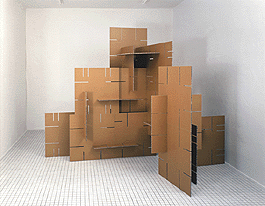Matthias Lengner
|
KASANOMADUM Consisting of just a few varied elements, the nomadic architecture KASANOMADUM appears as a form ever capable and ever in need of change – like a movement, which an existing piece of architecture absorbs and captures, so as to turn it around, and send it back, from the inside to the out. It reveals that aspect of the architecture in which it appears that cannot be seen. It leads a life of its own and is visiting Kunstnernes Hus in Oslo. And in showing something other than just itself, it recurs in everything that can be seen. It reterritorialises
itself, a process I have called functionalisation. the nomadic space The construction of this space of our imagination is the construction of a movement contrary to the existing construction of the space we assume to be reality. It is not the space of a counter reality, but rather the obverse of the space of our reality, without which this reality would not exist: the space
of the fiction The space of the KASANOMADUM is the space of roving thoughts. Reterritorialised, I call them fixed ideas. It was through KLARAKASA, which in 1992 became the first home of these roving thoughts, that fiction became fixed as fixed idea. In the meantime
these fixed ideas have been subjugated by the pragmatism of our
reality. They were contextualised, in order to check whether they
were sufficiently resilient. Thus we have had, in 1994 BESINKASA,
in 1995 , in 1999 KIOSKKASA, since 1999 Ausstellung der Ausstellung
(Exhibition of the exhibition) and in 2001 DEPOT. Temporary pieces
of architecture were erected and variously occupied according to
various needs. They transformed themselves and adapted to the diverse
requirements of the sedentary, which was thereby brought into question
so as to dissipate its determinative character. Matthias Lengner |

